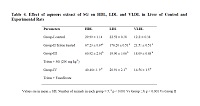Hypolipidemic activity of Sesbania grandiflora in triton wr-1339 induced hyperlipidemic rats
Keywords:
Sesbania grandiflora, Hyperlipidemia, LDL, VLDLAbstract
Hyperlipidemia is the greatest risk factor of coronary heart disease. Currently available hypolipidemic drugs have been associated with number of side effects. Herbal treatment for hyperlipidemia has no side effects and is relatively cheap and locally available. A literature claims that flavonoids can able to reduce the hyperlipidemia. Based on high flavonoid content in herbal, Sesbania grandiflora (SG) was selected and the present study focus on the anti-hyperlipidemic activity of aqueous extract of leaves of SG against triton induced hyperlipidemia in rats. SG administered a dose of 200µg/kg (p.o) to the triton induced hyperlipidemic rats. SG shows a significant decrease in the levels of serum cholesterol, phospholipid, triglyceride, LDL, VLDL and significant increase in the level of serum HDL at the dose of 200µg/kg (p.o) against Triton induced hyperlipidemic in rats. Aqueous extract of leaves of SG was investigated hypolipidemic activity on Triton induced hyperlipidemic profile. Aqueous extract fraction decreased serum level of total cholesterol by 69.72. On the other hand, aqueous extract of SG increased the serum HDL cholesterol level by 24.11. The reduction of LDL cholesterol level by aqueous extract was 30.31.
References
Grundy S M. Cholesterol and coronary heart
disease: a new era. J Am Med Assoc 1986;
: 2849-2858.
Davey Smith G. Cholesterol lowering and
mortality: the importance of considering
initial level of risk. Int. Med. J. 1993; 306:
-1373, Correction: 1648.
Saravanan R, Rajendra Prasad N, Pugalandi
KV. Effect of Piper betle leaf extract on
alcoholic toxicity in the rat brain. J. Med.
Food. 2003;6: 261-265.
Kaesancini AY, Krauss RM. Cardiovascular
disease and hyperlipidemia. Cur. Opi.
Lipidol. 1994; 5: 249-251.
Davey Smith G, Pekkanen J. Should there be a
moratorium on the use of cholesterol
lowering drugs? Br. Med. J. 1992; 304: 431-
Brown S L. Lowered serum cholesterol and
low mood. Br. Med. J. 1996; 313: 637-638.
Speight TM. In: Avery’s Drug treatment
Principles and Practice of clinical
Pharmacology and therapeutics. 1987, 3rd
Edition, ADIS press Ltd, p.599.
Berliner JA, Heinecke JW. The role of
oxidized lipoproteins in atherogenesis. Free
Radic. Biol. Med. 1996; 20: 707-727.
Takashi Suzuki, Yasuo Suzuki. Current topics
of lipid dynamics and pathobiology inmembrane lipid rafts. Biol. Pharm. Bull.
; 29: 1538-1541.
Ryan DH. Diet and exercise in the prevention
of diabetes. Int. J. Clin. Pract. 2003; 134: 28-
Anna Gramza, Jozef Korczak. (Camellia
sinensis L) as antioxidants in lipid systems.
Trends Food Sci. Tech. 2005; 16: 351-358.
Chopra RN, Nayer SL, Chopra IC. Glossary
of Indian Medicinal Plant. CSIR, New Delhi
, p.1224-1235.
A. Saravanakumar, K. Venkateshwaran,
J.Vanitha, V.S.Saravanan, M.Ganesh,
T.Sivakumar. Antibacterial activity of
methanolic extract of Sesbania grandiflora
(Fabaceae). Res. J. Pharma. Tech. 2008;1:67-
Singh R, Sidhu PS, Vadhera S, Sital JS,
Bhatia S. Extra-cellular invertase of
Rhizobium japonicum and its role in free
sugar metabolism in the developing root
nodules of Sesbania grandiflora. Physiol.
Plantarum. 1980; 48: 504-508.
Kirtikar KR, Basu BD. Indian Medicinal
Plants. Lalit Mohan Basu, 4, Leaders Road
Allahabad 1975, p.1061-1065.
Friedman M, Byers SO. Mechanism
underlying hypercholesterolemia induced by
triton WR-1339. Am. J. Physiol. 1957; 190:
-445.
Muramatsu K, Fukuyo M, Hara Y. Effect of
green Tea catechins on plasma cholesterol
level in cholesterol feed rats. J. Nutr. Sci.
Vitaminol. 1986; 56: 509-520.
Ding ZY, Chen Y, Zhou M, Fang YZ.
Inhibitory effect of green tea polyphenol and
murin on the oxidative modification of low
density lipoprotein. Clin. J. Pharmacol.
Toxicol. 1992; 6: 263-266.
Kellner A, Correll JW, Ladd AT. Sustained
hyperlipidemia induced in rabbits by means
of intravenously injected surface active
agents. J. of. Exp. Med. 1951; 93: 373-384.
Fiser RH, Denniston, Rindsig RB, Beisel
WR. Triglyceride secretion rates: use of
Triton in the rhesus monkey. J. of. Nutr.
; 104:223-226.
Schurr PE, Schultz JR, Parkinson TM. Triton
induced hyperlipidemia in rats as an animal
model for screening hypolidemic drugs.
Lipids. 1972; 7:69-74.
Ye-Yun Li, Chang-Jun Jiang, Xiao-Chun
Wan, Zheng-Zhu Zhang Da-Xiang Li.
Purification and partial characterization of bGlucosidase from fresh leaves of tea plants
(Camellia sinensis (L) O.Kuntze. Acta.
Biochim. Biophys. Sin. 2005; 37:364- 370.
Harbowy ME, Balentine DA. Tea chemistry.
Crit. Rev. Plant and Sci. 1997; 16: 415-480.
Otway S, Robinson DS. The effect of the
non-ionic detergent (Triton) on the removal
of triglyceride fatty acids from the blood of
the rats. J. of. Physiol. 1967; 190:309-319.
Khanna AK, Rizvi F, Chander R. Lipid
lowering activity of Phyllanthus niruri in
hyperlipidemic rats. J. of Ethnopharmacol.
; 82:19-22.
Del Bas JM, Fernandez-Larrea J, Blay M,
Ardevol A, Arola MJ, Blade C. Grape seed
procyanidins improve atherosclerotic risk
index and induce liver CYP7A1 and SHP
expression in healthy rats. FASEB. J. 2005;
:479-481.
Bruneton J. Elements de phytochimie et de
pharmacognosie, Technique &
Documentation Lavoisier, Paris, p.136-162.
Sochar M, Baquer NZ, Mclean P. Glucose
under utilization in Diabetes. Comparative
studies on the changes in the activities of
enzymes of glucose metabolism in rat kidney
and liver. Mol. Physiol. 1985; 7: 51-68.
Ji SK, Jung BJ, Chang WC, Sei CK.
Hypoglycemic and Antihyperlipidemic effect
of four Korean medicinal plants in alloxan
induced diabetic rats. Am. J. Biochem.
Biotech. 2006;2:154-160.
Chhanda Mallick, Rajkumar Maiti, Debidas
Ghosh. Comparative study on Antihyperglycemic and antihyperlipidemic effects of
separate and composite extract of seed of
Eugenia jambolana and root of Musa
paradisiaca in streptozotocin- induced
diabetic male albino rats. Ira. J. of Pharmacol.
Therapeu. 2006; 5: 27-33.



